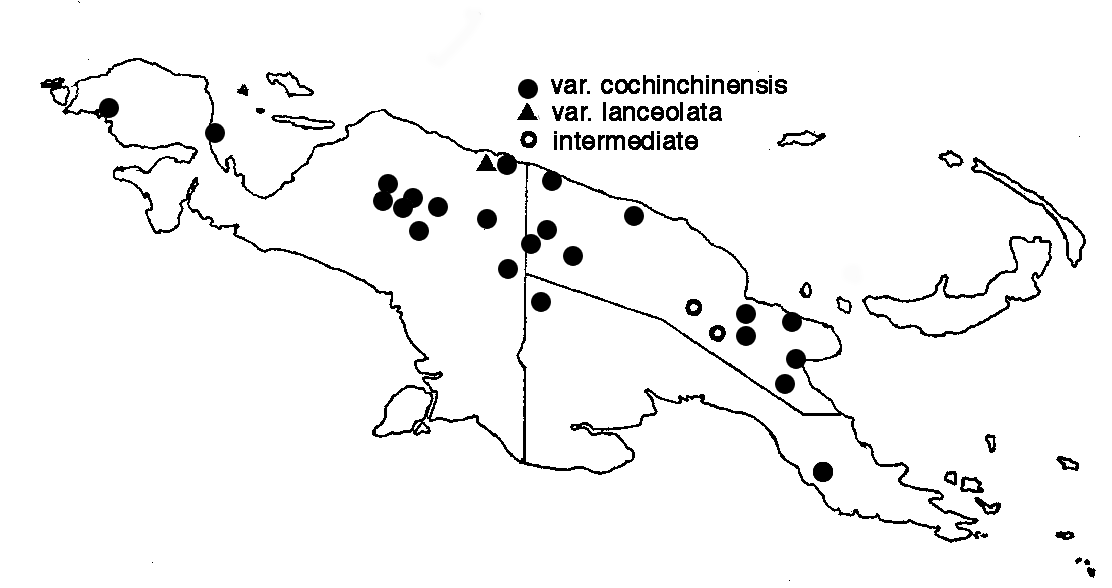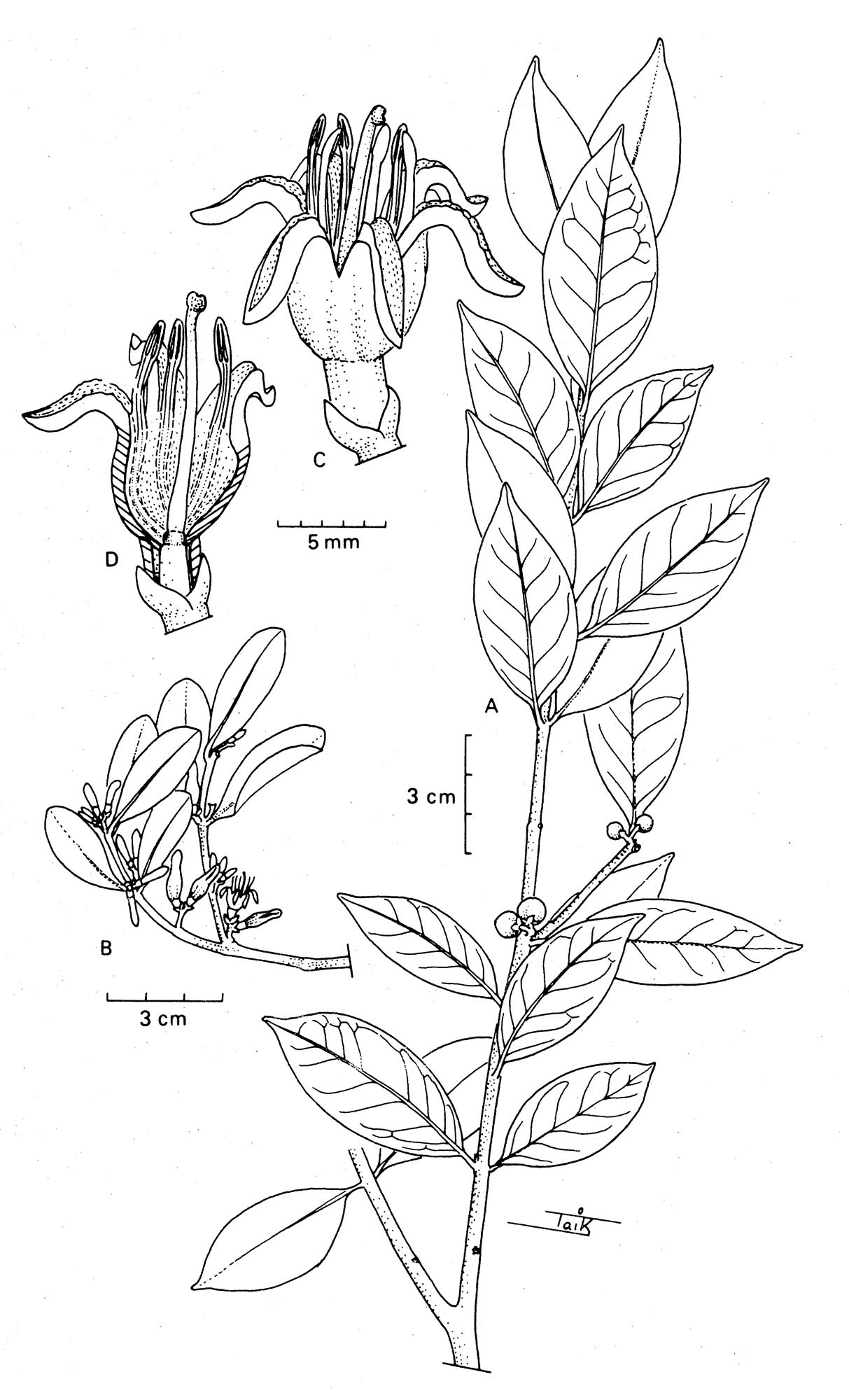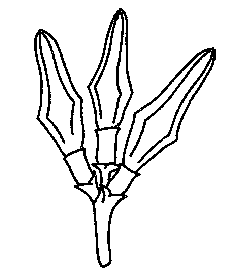
Distribution Map (Barlow 1974)

Description (Barlow 1974)
Macrosolen cochinchinensis (Lour.) Tiegh. Bull. Soc. bot. Fr. 41: 122 (1894); Dans. Bull. Jard. bot. Buitenz. 11: 279, illus. Fig. 4, g (1931); Back. & Bakh. v.d. Brink, Fl. Java 2: 69 (1965); Loranthus cochinchinensis Lour. Fl. coch. 1: 195 (1790); Elytranthe cochinchinensis (Lour.) G. Don, Gen. Hist. 3: 426 (1834). Type-The Loureiro specimen has not been located. Apparently it was never received at BM or LINN or P, and according to Merrill (1935) is not at Lisbon.
Elytranthe suberosa Lauterb. Nov. Guin. 8, 2: 816 (1912); Macrosolen suberosus (Lauterb.) Dans. Bull. Jard. bot. Buitenz. 10: 345 (1929); 11: 298, illus. Fig. 6, o-q (1931). Type-Hollandia, Gjellerup 148, 28.v.1910 (B, lectosyntype, photo in AD; U 32773; wRsL); Hollandia, Gjellerup 96, 30.iv.1910 (L 913103141, syntype; WRSL).
Elytranthe acutfolia Krause, Bot. Jahrb. 57: 471 (1922). Type.-Felsspitze, Ledermann 13067, 22.viii.1913 (B, photo in AD).
Elytranthe ledermannii Krause, Bot. Jahrb. 57: 472 (1922). Type-Hugellager, Sepik R., Ledermann 12351, July 1913 (B, photo in AD).
Elytranthe torulosa Krause, Bot. Jahrb. 57: 472 (1922). Type.-Pyramide, 400 in alt., Ledermann 7622, 16.vi.1912 (B, photo in AD).
Elytranthe verrucosa Krause, Bot. Jahrb. 57: 473 (1922). Type.-Waubebach, Schlechter 19446, 16.v.1909 (B, photo in AD).
Elytranthe spathulifolia Krause, Bot. Jahrb. 57: 473 (1922). Type.-Ibo Mts., Schlechter 17794, 27.v.1908 (B, photo in AD).
Elytranthe diversifolia Krause, Bot. Jahrb. 57: 474 (1922). Type.-Kani Mts., Schlechter 17030, 24.xii.1907 (B, photo in AD).
Elytranthe leucophloea Krause, Nov. Gum. 14: 100 (1923). Type.-Ridge to Doorman Top, 1450 in alt., Lam 1901, 5.xi.1920 (B, holotype, photo in AD; L 926134822).
Elytranthe bruynii Krause, Nov. Gum. 14: 101 (1923). Type.-Idenburg R., 40 in alt., de Bruyn 78, 19.viii.1914 (B, holotype, photo in AD; P; L 926134852; U 78802).
For very extensive further synonymy of this species, see Danser, Bull. Jard. bot. Buitenz. 11: 279, 298 (1931); 16: 5 (1938).
Glabrous and very rarely glaucous. Petiole 3-l0-(l5) mm long, flat or channelled above; lamina broad lanceolate to ovate (rarely narrower or broader), (4)-7-l0-(16) by (l)-3-5-(l0) cm, usually somewhat shining above, dull below, gradually to abruptly contracted at the base or very rarely slightly cordate, slightly recurved at the margins, usually acute and more or less acuminate at the apex but often rounded; venation pennate with the midrib distinct below and other venation only faintly visible. Inflorescences solitary or few in the axils; peduncle longitudinally ridged, slender, often with an involucre of 1-3 sterile bracts at the base or on the peduncle, bearing (l)-2-4-(5) flowers, 4-8-(12) mm long; pedicels 0-3 mm long; bracts acute, spreading, 1-2 mm long. Calyx funnel-shaped; limb truncate or weakly 6-toothed, 0.3-0.5 mm long. Corolla in the mature bud strongly 6-alate and inflated in the middle, 9-14-(23) mm long; petals in the open flower united into a campanulate tube 4-8-(12) mm long with the lobes strongly reflexed. Anthers 1-1 5 mm long, c. 1/3 the length of the free parts of the filaments. Style articulate near the base, leaving almost no nipple on the fruit. Fruit globular. (Description based on the New Guinean materials.) (Fig. 1, n.)
Occurrence. New Guinea, from the Vogelkop to the Sogeri Plateau (Fig. 2), mainly sea level to 1600 in altitude, but occasionally as high as 2350 in. Also from Indomalaya to southern China and the Himalayas.
Danser treated the New Guinean material he saw as an endemic species, M. suberosus, but commented on its close similarity with M. cochinchinensis. The range of variability shown by the collections now available makes it impossible to maintain M. suberosus as a species distinct from M. cochinchinensis, which even in the narrower sense of Danser is very polymorphic, and which grades imperceptibly into the New Guinean forms. Some of the variation in the species may be clinal, as the New Guinean specimens, apart from being entirely glabrous, commonly have small dimensions and very few flowers in the inflorescence.
Key to Varieties of M.
cochinchinensis
Leaves broad lanceolate to ovate, more than
2 cm wide, acute to rounded at the apex, often somewhat acuminate
but not strongly so la. var. cochinchinensis
Leaves lanceolate, less than 2 cm wide, acute and acuminate
at the apex lb. var. lanceolatus
1a. var. cochinchinensis
Lamina broad lanceolate to ovate, more than 2 cm wide, acute to rounded and often weakly acuminate at the apex. Chromosome Number-n = 12, 11 (see below).
Occurrence. Throughout the species range (Fig. 2).
Representative Specimens. WEST IRIAN: Beriat, c. 12 km S. of Teminaboean, Kalkman BW 6257, 20.iv.1958 (L; CANB). EASTERN NEW GUINEA: Swamp near Red Hill, c. 15 miles W. of Lae, Barlow 922, 5.ii.1965 (AD; LAE; BRI); Sogeri Plateau at foot of Kokoda Trail, c. 600 m alt., Barlow 975, 20.ii.1965 (BRI; L; LAE).
A chromosome number of n = 12 was recorded for M. cochinchinensis by Schaeppi and Steindl (1942) from Malesian material. New determinations recorded by Barlow and Wiens (1971) are as follows: n = 12 (voucher Barlow 922); n = 11 (voucher Barlow 975). This is the first record of aneuploidy within a species of Loranthaceae, and the first record of a number other than n = 12 in tribe Elytrantheae. In the form with n = 12 there are two bivalents larger than the others, while in the form with n = 11 there are three larger bivalents. it is possible that aneuploid reduction has occurred following unequal interchange of chromosome segments. It is note-worthy that the determination of n = 11, which was made on the only plant sampled from the population, is from the first and only collection of the species from Papua.
lb. var. lanceolatus Barlow, var. nov.
Type-New Guinea, near Karap Village, Jimini Valley, 1750 in alt., Womersley and Millar NGF 7755, l0.vi.1965 (LAE 13203, holotype; L 956264466).
Folia lanceolata, 5-9 cm longa, 1-2 cm lata, apice acuta acuminata.
Lamina lanceolate, less than 2 cm wide, acute and acuminate at the apex. Chromosome Number.- n = 12 (Barlow and Wiens 1971). Voucher: Barlow 963.
Occurrence. Highlands of eastern New Guinea (Jimmi and Purari drainages) (Fig. 2), 1750 to 2350 in altitude. Some specimens from the Celebes can also be referred to this variety.
Specimens Examined. EASTERN NEW GUINEA: Between Chuave and Kundiawa, c. 2350 m alt., Barlow 963, 15.ii.1965 (AD; BRI L; LAE).
The variety is an extreme of variation of the very polymorphic M. cochinchinensis. Even though the differences on which it is based are conspicuous, the variety probably has little taxonoinic significance. Intermediate specimens between it and the typical form have been seen.
Intermediate Specimens Examined. WEST IRIAN: Cycloop Mts., above Ifar, 400-600 m alt.,
McKee 1863, 31.xii.1964 (L); Cycloop Mts., ridge E. of
pass between Ifar and Ormoe, 1340 m alt., van Royen and Sleumer
6108, 30.vi.1961 (L; LAE).
Illustrations

Macrosolen cochinchinensis. A - branch with fruit. B - twig with flowers. C - flower. D - flower front section cut away [inaccurately shows perianth separated from ovary. The ovary is inferior]. From Barlow (1981).

Macrosolen cochinchinensis. Inflorescence. From Barlow (1974).
Photographs
See Parasitic Plant Connection page HERE
and scroll down to this species.
Macrosolen cochinchinensis
updated 09 September 2010